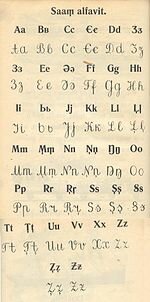Top 10 Lost Languages
Suggested by SMSThere are probably millions of people who wonder, at one time or another, how the language that they speak came into existence? That only makes it fair to assume that there are those who wonder about verbal communication in the past. No doubt, man evolved from guttural moan and physical gestures; to words that contained syllables. Even if these words were communicated on paper with what appears to be squiggly lines, it was a language. There are several facts that should be considered when thinking about lost languages.
- There are civilizations known to man that no longer exist.
- These civilizations spoke to one another, just as people do today.
A question that many people have asked is, “What happened to those languages when the civilizations that spoke them vanished?” The answer is rather simple; they became the lost languages that helped to make this list possible.
Although some lost languages are still used in religious and scholarly circles, the people who considered them their native tongues are no longer around. As a result, they fall into the abyss of history. Many remain hidden until someone trips across a trace of them. However, they leave behind a reminder of people who may have once wondered the same questions about those who came before them.
10. Ge’ez

Ge’ez is also referred to as Ethiopic due to its development in Ethiopia and southern Eritrea. It’s an ancient Semitic language, which became the official tongue of the Kingdom of Aksum and the imperial court of Ethiopia. Since this language is no longer spoken, by anyone, the correct pronunciation of some of the consonant sounds isn’t known. They are often pronounced using the sounds of Ethopian Semitic, although the difference in letters clearly proves that there is some other way to pronounce the letters. Today, value is given to letters using the Proto-Semitic consonants that they are believed to have been derived from.
Ge’ez is a language that can be considered as completely lost. It only remains as the primary tongue of a variety of churches in Ethiopia and the Beta Israel Jewish Community. Aside from being used in sermons and religious services, there is no trace of it among the people of the land.
9. Avestan

This ancient Eastern Iranian tongue is only familiar due to its use in the Zoroastrian scripture, which is how it got its name. The area from which it derives has often been thought to be a picture of East Iranian culture for archaeologists. Because of changes in linguistics, it became very important to create a writing system for the language before it disappeared.
By the time the 3rd century came around, an alphabet system had been put in place to document the language. This alphabet was derived from another script, which had been modeled after Aramaic. Like most writing of that time period, script was read from right to left. There are more letter in the Avestan alphabet that the other two. In addition, there were a lot of consonants in the alphabet. Time was taken to learn to pronounce the letters of this language in order to preserve the hymns that were originally written in the sacred language.
8. Coptic

Also known as Coptic Egyptian, this northern ancient, Afro-Asiatic language was spoken until the 17th century. By the time of the 1st century, the Greek alphabet had begun to be used as the new writing system. The Coptic script also included about seven symbols that were used to represent the Egyptian sounds that weren’t represented in the Greek alphabet. There are a multitude of Coptic dialects. The most notable, however, are Sahidic and Bohairic.
Coptic was a written in Hieroglyphics and was closely related to Late Egyptian. The language began to grow between the 2nd and 13th centuries. The Bohairic dialect is still classified as the official language of the Coptic Orthodox Church of Alexandria. To date, it’s believed that Coptic was only spoken by 300 people. This may suggest that it was a local dialect and more of tribal language.
7. Old Church Slavonic

The first Slavic language, this ancient tongue came about in the 9th century. It was preserved in the form of several written documents and inscriptions in the areas that were once the Moravian Empire. Is writing system was developed by missionaries, Saint Cyril and Methodius, who did their first missionary works in the region. The two were later hailed for using the language to translate the Bible and other ancient texts; in an effort to bring Christianity to Slavic people. It is still considered the primary, base language of many Slavonic churches.
Old Church Slavonic is the most aged, attested Slavic language. However, it isn’t the primary language from which other Slavic tongues were derived. It is more so a single dialect of another branch of the languages.
Although there were multiple versions of the language, the Old Church version stayed the same, for the most part. It went through minor changes over time; that only affected its name. For example; there is Church Slavonic, which is also called Church Slavic. Yet, for historical documents, the terms “Old Church Slavonic” or “Old Church Slavic” are used. The language is also referred to as Old Bulgarian at times, as a direct reference to the location of which the original manuscripts were located.
One should keep in mind that there are no precise events that clearly separate the periods to determine which would be considered the “Old Church” period.
6. Cochimi

This language has been attached to Jesuit documents of the 18th century. Texts written in this language have provided proof that it is a relative of the Yuman languages. The Yuman languages are spoken by the aboriginals that lived in the valley along the Colorado River, in the western parts of Arizona and in Mexico. There are 10 languages in the Yuman-Comichi family. Of them all, the only one to become extinct is ironically called, Cochimi.
Cochimi once consisted of two dialects. One was spoken to the north and the other to the south. The language became extinct in the early part of the 20th century. With so many other languages in the family, great lengths are being taken to ensure that the rest of them remain. Groups have taken to learning and teaching their children more than one language from the family, in an effort to keep the languages alive.
5. Akkala Sami
This Sami language was spoken in the A’kkel and Cu’kksual villages, located in the inlands of the Koala Peninsula in Russia. At one time, the tongue was thought to be a dialect of Kildin Sami. However, it was recently determined to be a totally independent Sami language; which may closely be related to the west’s Skolt Sami.
Akkala Sami is considered to be the most endangered version of the language. One of the last fluent, native speakers died at the end of 2003. There are two other people, both older in age, that have some sort of knowledge of the dying language. Once they have passed on, the language will be extinct. Unfortunately, Akkala Sami is the most poorly recorded or documented version of the Sami language. With nothing for historians to go on, there is little chance of reviving the lost language. The only way is to try to use the last survivors to gather as much information as possible.
4. Sanskrit

One of the most popular lost languages is historically categorized as Indo-Aryan. It is the primary basis of languages related to Hinduism, Buddhism and Jainism. Although Sanskrit is considered among the many lost languages, it’s listed as one over two dozen scheduled languages of India. It is also known as the official language of Uttarakhand. Sanskrit is a language that is held in the same regard as Latin and Greek in Indo-European studies.
There are two distinct versions of Sanskrit. The first, classical Sanskrit is the typical grammar used in Panini. It is one of the major influences of the languages spoken India, Pakistan, Sri Lanka and Nepal, today.
However, before there was classical Sanskrit, there was Vedic Sanskrit. One of its subfamilies, Rigveda, is the oldest form of the language to be preserved; dating back to at least 1500 BC. At one time, there were 14,000 people who spoke the language. The last recorded Sanskrit speaker died in Monterey, California in 1939. Sanskrit is still used in some Indian institutions; all in an attempt to revive the language.
3. Mayan Languages

The language family that was spoken in the northern region of Central America and in Mesoamerica was created by the Mayan languages. The Mayan languages are spoken by at least a half dozen million Mayans, locates in Guatemala, Mexico, Belize and Honduras. Towards the end of the 1990’s, Guatemala officially recognized nearly two dozen Mayan languages, by their proper names. In addition, Mexico formally recognized close to 10.
This language family is one of the most accurately recorded and studied languages in South, North and Central Americas. The modern versions of the language are descended from Proto-Mayan; which is believed to have been spoken at a minimum of 5,000 years ago.
Among the earliest people in the civilization, there was a single version of the language. That Mayan language went through conversions due to interactions between people in Mesoamerica. However, all versions of the language bear similarities. For one, they all use relational nouns. As well, they are set apart from other languages of the area by grammatical and typological characteristics. In Mesoamerican history, pre-Columbian, there were a few Mayan languages that were written using a Mayan hieroglyphic system. The use of this writing system became popular throughout the Mayan civilization’s classic period.
It is believed that the last fluent speaker of the language died within the last 5 years.
2. Biblical Hebrew

Often referred to as Classical Hebrew, Biblical Hebrew is a Canaanite Semitic language that originated in Canaan. It is believed to have come from the area between the Jordan River and the Mediterranean Sea. Biblical Hebrew has been dated back to approximately the 10th century BC. However, it survived through the Second Temple period, which ended in 70 AD. In other words, this language was the language spoken at the time of Jesus Christ!!!
This ancient language evolved over time; transforming to another language, called Mishanaic Hebrew. This version of Hebrew was spoken until the second century AD. Biblical Hebrew is mostly recognized as the language of the Hebrew Bible; making it one of the most well-known lost languages in the world.
A vocalic system was added around the Middle Ages. There have been noted differences in the language as it is spoken in different parts of Israel. This was mostly visible in vocabulary, noun usage and phonology. The language has been written with the use of various systems. In the 12th century, BC, the Phoenician script was used. As the language began to evolve, so did the writing system. Eventually it began to be written using the Paleo-Hebrew script.
1. Latin

Latin is the original language of Latium and Ancient Rome. It is a derivative of the ancient Proto-Indo-European language and its origin has been traced back to want is now known as the Italian peninsula. The language, although considered dead, is still fluently spoken amongst intellectuals and members of clergy in the Christian faith. In addition, it is still taught in many schools and institutions of higher learning.
The Latin language had its own alphabet, which was taken from the Old Italic one. The latter was taken from the Greek and Phoenician alphabet systems. Oddly, classical Latin was written without punctuation, without lowercase letters or spacing; spacing was replaced with what is known as an interpunct. Furthermore, the Latin alphabet’s letter count has varied at different periods in history.
One of two surviving languages of the Italic language family, the tongue is still often used to create new words for many other languages; English included. Any other branches of the Italic family are only referred to in documents from early Italy.
The dead language is used in it’ Ecclesiastical form when laws and decrees are issued by the heads of the Catholic Church. It can also be found in writings that are produced by the world of science. Classical Latin can be found in the course study of some schools as part of lessons in “Classics”; it’s often paired with Greek. However, Latin has become more and more unpopular since the early years of the 20th century. Still, Latin will always be known as one of the original languages of romance.
This is merely a short list of languages that are no longer spoken. It’s amazing that at some point within the last 10 years, there was still someone who fluently spoke at least 3 of these languages. With those sole carriers gone, their native tongues are lost forever. Only giving hope that they left records of what they were sure to know was the end of a civilization, in any form.
Many of these languages are traced back to eras that were significant to the world. Some are linked to civilizations that left their mark and have taken historians on wonderful journeys into the past. Some may have left no clues. The one thing they all have in common is that at one time, they existed.










